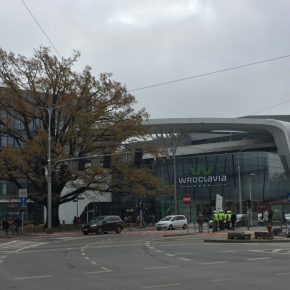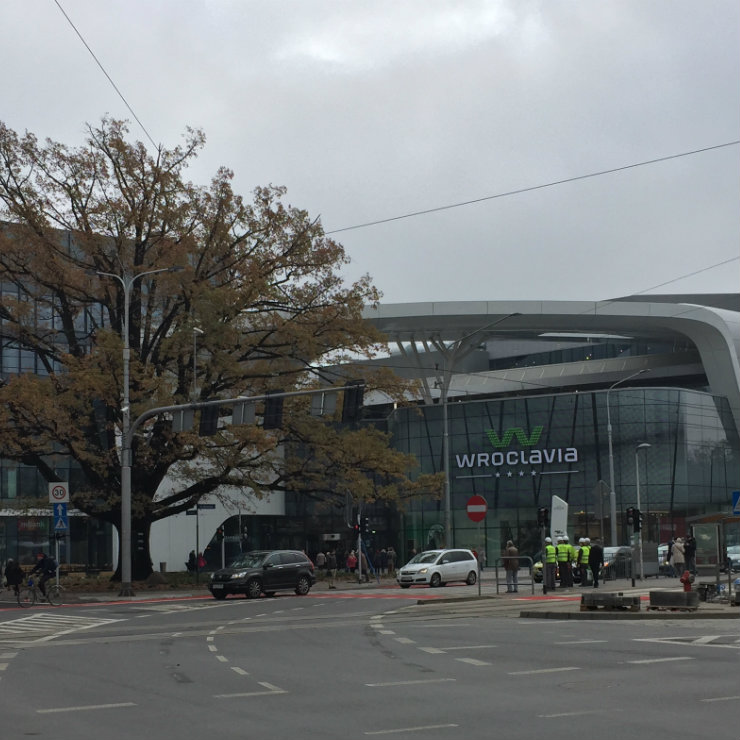
Wroclavia shopping center, Wrocław, Poland (Piotr Michalak, CC BY-SA)
At the end of December 2017, total modern retail stock in Poland (including traditional shopping centres, retail parks, strip malls and outlet centers) was 11.54 million sqm GLA, or gross lettable area, in 489 retail projects, according to a Polish Retail Research Forum (PRRF) summary of the retail market in Poland after H2 2017.
In H2’17, 351,000 sqm of GLA was delivered in Poland. The space included: new schemes (e.g. Wroclavia in Wrocław, Galeria Północna in Warsaw), extensions of existing projects (e.g. Homepark Franowo in Poznań and Galaxy in Szczecin) and redevelopment of the building which has been excluded from the modern retail stock for the duration of the construction works (ETC Swarzędz).
At the end of 2017, two retail schemes located in Bydgoszcz: CH Glinki (redevelopment into Metropolitan Outlet) and Bydgoskie Centrum Finansowe (redevelopment into office function), have been excluded from the modern retail stock. As a result of these changes, the vacancy rate in Bydgoszcz decreased by 3.5 pp, to 1.9 per cent.
Approximately 533,300 sqm of GLA was identified under construction at the end of December 2017. Over 83 per cent of the volume is expected to be delivered in 2018 and includes large-scale projects in the major agglomerations, e.g. Forum Gdańsk (62,000 sqm), Galeria Libero in Katowice (45,000 sqm) and Gemini Park in Tychy (36,000 sqm). The largest project, which is currently under construction is Galeria Młociny in Warsaw (75,000 sqm), planned to be delivered in 2019.
Apart from new schemes, the volume of space under construction includes extensions of existing projects. At the end of 2017, they accounted for some 10 percent of the total retail space being built, within e.g. extensions of Morski Park Handlowy by 16,500 sqm of GLA or Centrum Handlowe Janki by 21,000 sqm of GLA.
Vacancy rate for the largest 18 retail markets in Poland amounted to 4.0 per cent at the end of December 2017 (a decrease from 4.1 per cent at the end of June 2017). Closed DIY stores of Praktiker have impacted the most the level of vacant space in 2017 and only some of the space had been leased to other operators. In H2’17, Jatomi Fitness closed two of their gyms (in Złote Tarasy in Warsaw and in Millenium Hall in Rzeszów) and also announced the company’s withdrawal from the market. Absorption of retail space formerly occupied by Alma by other grocery tenants and the exclusion of two schemes in Bydgoszcz caused a slight decrease of the vacancy rate.
The highest level of vacant space amongst the major agglomerations was registered in Katowice (5.8 per cent) and in Poznań (5.3 per cent). The highest increases of the factor were noticed in Poznań and Tricity by 0.8 pp in each. The lowest vacancy rates at the level of 2.9 per cent were noticed in Warsaw and Wrocław.
Amongst the seven retail markets of population within 200,000 to 399,000, the highest level of vacant space was identified in Radom (8.5 per cent) and Częstochowa (6.6 per cent), and the lowest – in Toruń (1.7 per cent) and Bydgoszcz (1.9 per cent).
In four cities with 150,000 to 199,000 inhabitants, the vacancy rates stood at the level of: 1.8 per cent in Kielce, 2.2 per cent in Rzeszów, 1.9 per cent in Olsztyn and 3.8 per cent in Bielsko-Biała. In the latter, the increase of the vacancy rate by 2.4 pp was noticed, which was caused by the closure of Piotr i Paweł in Galeria Sfera and the Decathlon store in Karpacka Retail Park.
In Q4’17, Polish Retail Research Forum prepared a classification of the analyzed retail projects in Poland. Existing schemes were catalogued by format (shopping centers, retail parks, strip malls and outlet centers), location (city center, in town and out of town) and catchment area (local or regional). Additionally, each shopping centre was rated in four-level scale, according to the quality of its offer.
About 85 per cent of the modern retail area analyzed by PRRF are the traditional shopping centers. According to the research, up to 50 per cent of analyzed modern retail schemes were the 3- and 4-star projects (with strongly developed fashion, service and entertainment offer), what shows the high quality of shopping centers located in Poland. Almost 10 per cent of modern retail stock are retail parks (including the smaller ones – strip malls), while the rest (5 per cent) are outlet centers.


